If you’re evaluating this convertible because other options aren’t available. don’t despair. But there are other, better values out there for a budget PC.
Mark Hachman / IDG
Today’s Best Tech Deals
Picked by PCWorld’s Editors
Top Deals On Great Products
Picked by Techconnect’s Editors
HP Pavilion x360 Convertible 14 (dw0097nr)
Show More
The HP Pavilion x360 Convertible 14 (dw0097nr) is a competent convertible laptop for handling the day-to-day workload of a work-from-home or distance-learning experience. It also offers some unique features, including a rare cellular option and a full-sized SD card slot. The USB-C and HDMI ports allow for two additional displays, including 4K support. While these attributes work in the Pavilion x360’s favor, its middling performance and underwhelming battery life make other laptops we’ve tested in its price range seem like a better deal.
This review is part of our ongoing roundup of the best laptops. Go there for information on competing products and how we tested them.
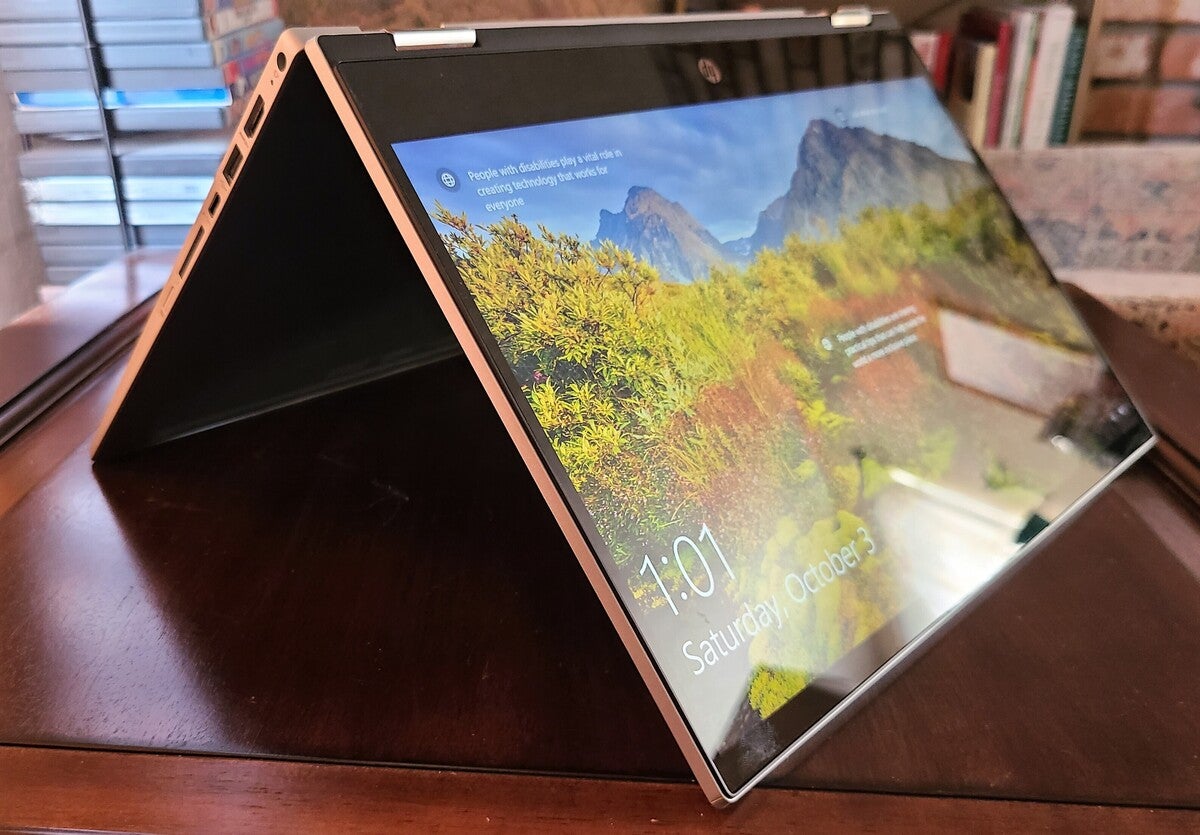 Mark Hachman / IDG
Mark Hachman / IDGAs a convertible, HP’s Pavilion x360 Convertible 14 rotates easily into tent mode. The hinge is engineered well, preventing the laptop from sagging, even as it approaches a 180-degree angle.
HP Pavilion x360 Convertible 14 basic features
HP’s Pavilion x360 Convertible 14 hasn’t been on the market for long, but you may find that you’ll have a difficult time buying one—evidence of the buying spree brought on by the need to work/study from home during the pandemic. The laptop is currently available for $700 on HP.com, but in the course of the review it was sometimes sold out.
In case you can’t find it, HP representatives recommended some virtually identical alternatives. The $650 HP Pavilion x360 Laptop 14t-dw000 lacks the Optane memory option and LTE WWAN. The $586.95 HP Pavilion x360 14t-dh200 is even more similar, though it also lacks WWAN options and you’ll need to pay a bit more for the 1080p display option. Both the 14t-dw000 and 14t-dh200 were in stock at press time, however, and should offer comparable performance.
Keep in mind that in all these machines, the processor’s “G1” suffix denotes the minimal amount of graphics capability provided. Higher-end members of Intel’s 10th-gen Ice Lake family offer more visual horsepower.
Here are the specs for the unit we tested:
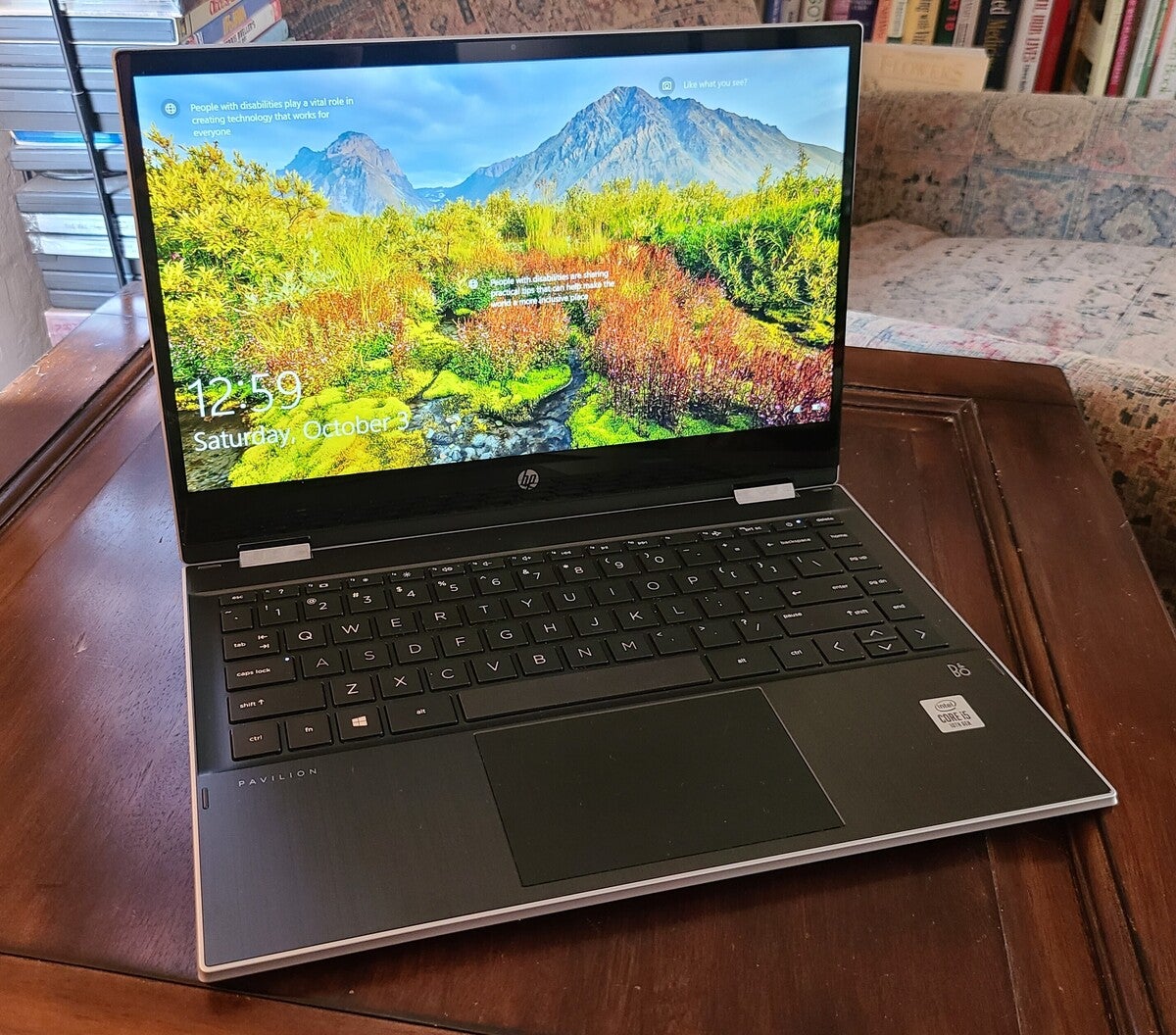 Mark Hachman / IDG
Mark Hachman / IDG- Display: 14-inch (1920×1080, WLED) multitouch, 250 nits (rated)
- Processor: Intel Core i5-1035G1
- Graphics: UHD 620
- Memory: 8GB DDR4-3200 SDRAM (1 x 8 GB)
- Storage: 256GB SSD+16GB Optane
- Ports: 1 USB-C 3.2 Gen 2 (10Gbps, charging, display), 2 USB-A 3.2 Gen 1 (formerly USB 3.1, 5Gbps), 1 HDMI 2.0, SD card slot, 3.5mm jack, SIM slot (as reviewed)
- Camera: 720p (user-facing)
- Battery: 41.3Wh (reported), 43Wh (rated)
- Wireless: WiFi 6 (Intel Wireless-AC 9461 802.11ac) and Bluetooth 5, with Connected Modern Standby; Intel LTE (XMM 7360) SIM slot (as reviewed)
- Operating system: Windows 10 Home
- Dimensions (inches): 12.76 x 8.70 x 0.74 inches
- Weight: 3.55 pounds
- Color: Natural Silver (Exterior)/ Ash Silver (Interior)
- Price: $700 at HP.com
Overall build quality and display
HP’s Pavilion x360 14 emerges from its box a bit on the heavy side, though that’d only be an issue if you actually traveled with it. Our review unit boasts the rather generic Natural Silver exterior. A narrow band of silver runs around the edge of the Dark Ash Silver keyboard deck.
Because the Pavilion is a 360-degree convertible, it flips smoothly from clamshell back into tent mode, supporting its own weight. During a year when we’ve been stuck inside most of the time, I’ve grown to appreciate laptops that can serve as portable entertainment centers during off hours.
Above the keyboard lies an unobtrusive grille from which the Pavilion x360 14 vents its warm air. The laptop puts out a steady whoosh of fan noise, even occasionally during routine tasks such as typing this review. It’s both soft and fairly constant enough, however, to fade into the background as white noise.
 Mark Hachman / IDG
Mark Hachman / IDGAir is pulled in from a wide grille underneath the laptop through a second grille on its left side.
HP’s display is passable, a common quality level among lower-priced laptops. Its backlight has a top brightness of about 250 nits, the bare minimum for what we consider to be sufficient for indoor work. My downstairs office gets minimal outside light, and I found the display to be just slightly on the dim side. Color fidelity seemed adequate, however, with sufficient viewing angles from either side. Just don’t expect to use it outdoors.
At this price point, a laptop’s aesthetics should be a bonus, not part and parcel of the experience. No one can help but notice, though, the wide lower display bezel of about an inch and a half. Though the side (quarter-inch) and the top (three-eights of an inch) bezels are slimmer, the overall effect is that the display feels a bit cramped.
Fortunately, the available ports adorning the HP Pavilion x360 Convertible 14 make it easy to expand beyond the built-in display. HP includes both an HDMI 2.0 as well as SuperSpeed 10Gbps (formerly known as USB-C 3.2 Gen 2).
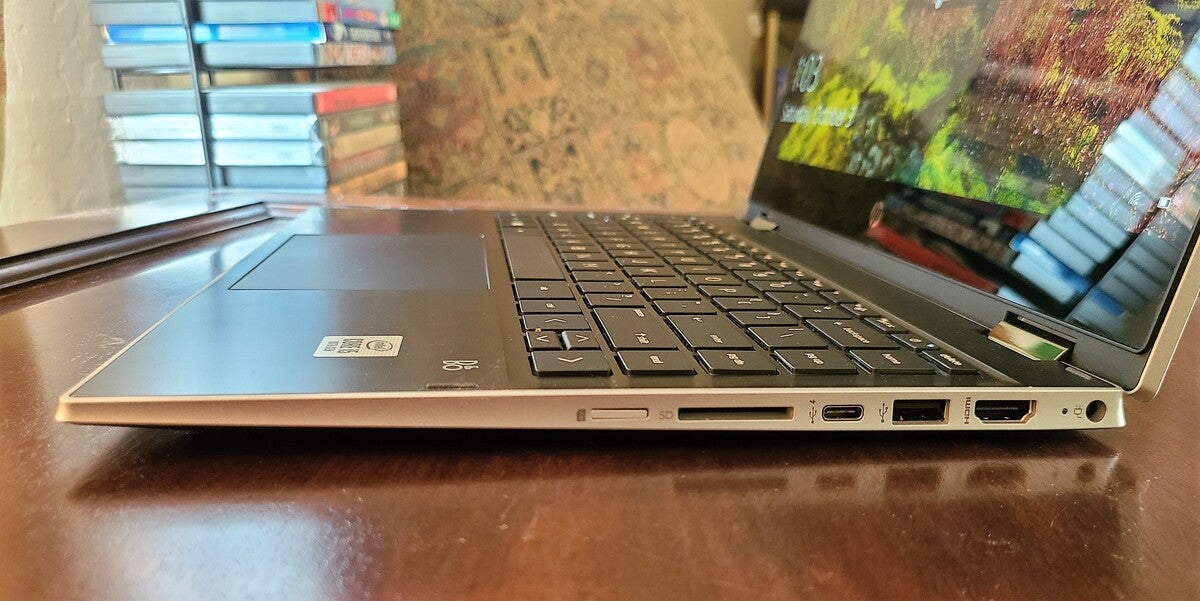 Mark Hachman / IDG
Mark Hachman / IDGThe right side of the HP Pavilion x360 Convertible 14 (dw0097nr) includes a port for the barrel charger, HDMI 2.0, USB-A, standard USB-C (not Thunderbolt), a full-sized SD card slot, and the SIM card slot.
Unfortunately, though the HDMI 2.0 cable supports a single 4K monitor at up to 60Hz, the Core i5-1035G1 couldn’t manage to push my external 4K display beyond 30Hz. For those with sensitive eyes, the slow refresh rate can look jarring. Anything with motion—video, for example—can look jerky and, over time, can fatigue your eyes. Even typing on an otherwise static screen can be wearing. This problem, however, completely goes away if you have an external 1080p monitor, which the Pavilion x360 14 powers at a comfortable 60Hz.
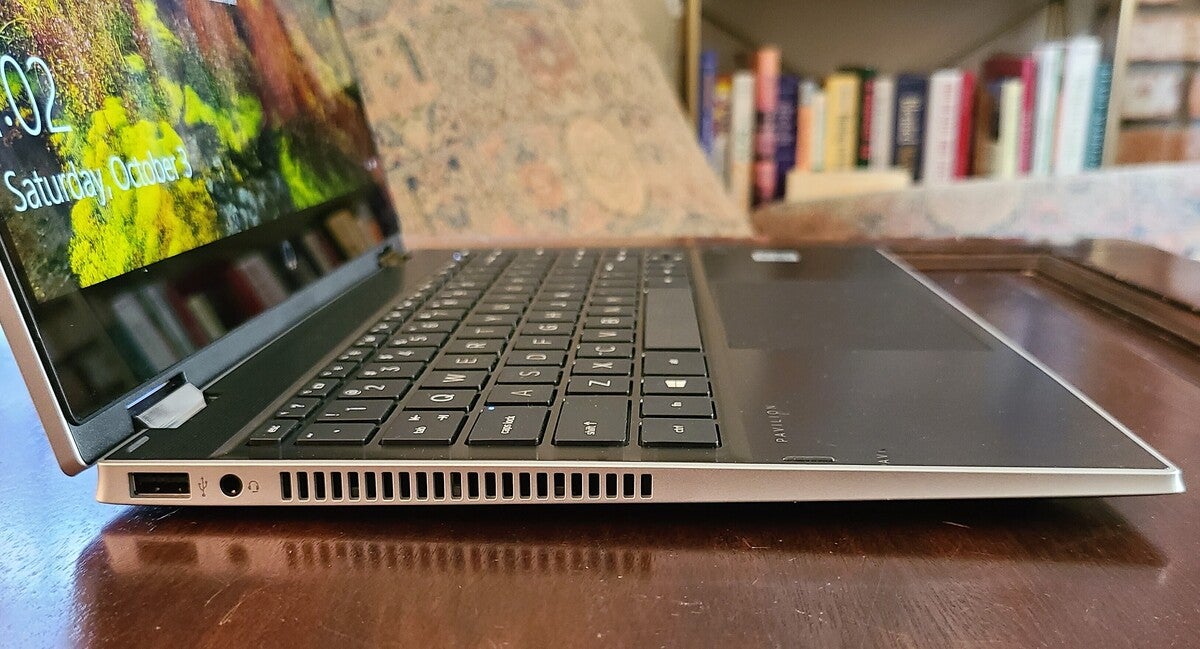 Mark Hachman / IDG
Mark Hachman / IDGAnother USB-A port sits on the left side of the HP Pavilion x360 Convertible 14, along with a grille to vent the laptop’s thermal exhaust.
HP supplies a 45W power supply inside of the box, which uses a round “barrel” connector to charge the laptop. Alternatively, you can use a third-party charger to charge the laptop via the USB-C port.
Typing, audio and camera
I tend to prefer keyboards with more pronounced key travel, so the shallow keyboard on the HP Pavilion x360 Convertible 14 wasn’t especially comfortable over prolonged use. I almost always write a laptop review on the keyboard of the device that I’m reviewing, and I’ll be happy to go back to something which allows my fingers more flexibility.
My only other complaint is that the individual keys aren’t especially large. Otherwise, the Pavilion’s keyboard provides a comfortable typing experience. Its only other quirk is the column of Home, Pg Up, and related keys that runs along the right side of the keyboard, rather than the lower right-hand corner (as is more common).
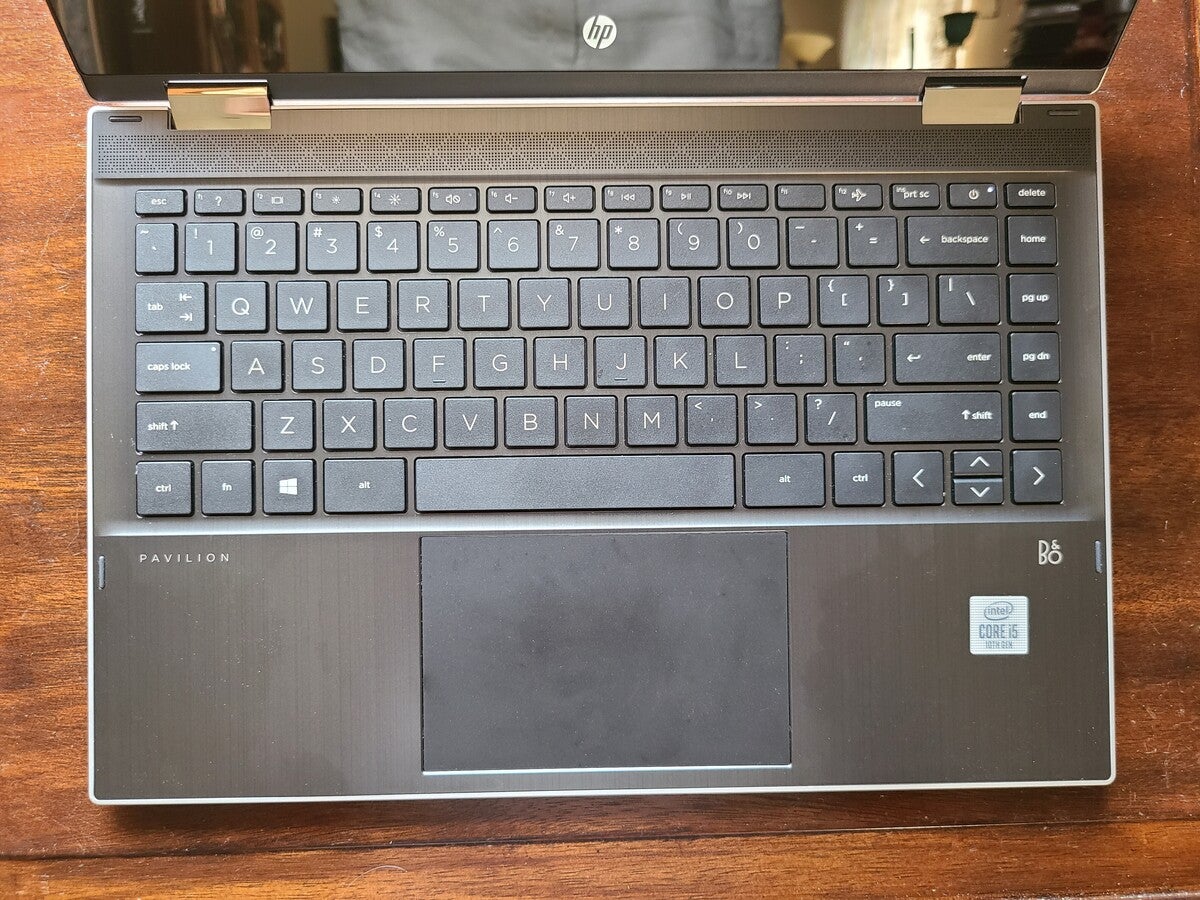 Mark Hachman / IDG
Mark Hachman / IDGThe keyboard of the HP Pavilion x360 Convertible 14 (dw0097nr).
Laptop audio is rarely good, and the Pavilion x360 Convertible 14 failed to convince us otherwise. Its speakers are thin, tinny, and generally unpleasant for listening to music or other audio, possibly because of the lack of low-end boost. Mid- to high-pitched music, like Molly Sandén’s “Husavik (My Hometown),” for example, sounded pretty good.
Normally, audio enhancement technologies help somewhat. Bang & Olufsen tuned the speakers and provided an audio utility conveniently designed with an equalizer and noise cancellation for the available microphone. But even headphones can’t really help; your best bet is to boost the bass as much as possible.
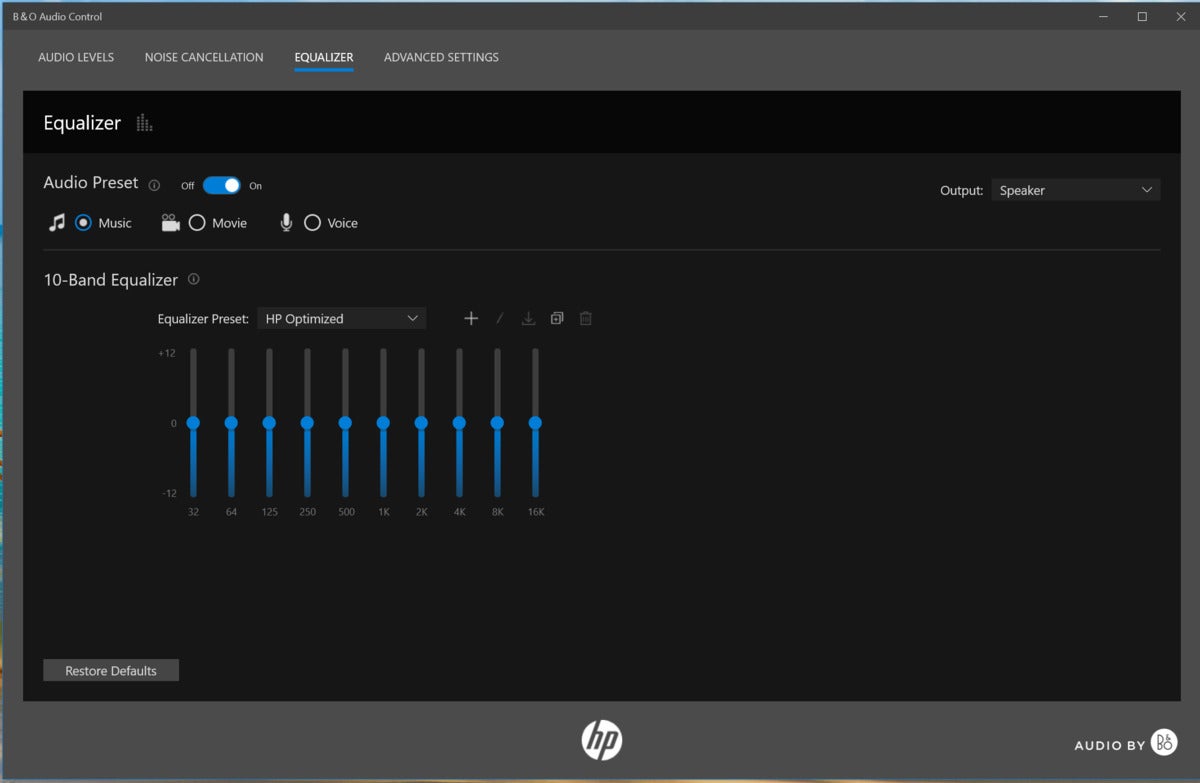 Mark Hachman / IDG
Mark Hachman / IDGHP’s convertible Pavilion is tuned by B&O, but it doesn’t really help.
The same utility manages the microphone’s noise cancellation, which I found to be somewhat hit-and-miss. The B&O utility can be configured to filter out everything but your voice. It did a superb job at filtering out the back-and-forth of baseball announcers calling the game while I recorded my voice. One consequence, though, is that my voice’s volume levels fluctuated unexpectedly, which would be noticeable on a Zoom call. Using a headset should bypass all these limitations.
The HP Pavilion x360 Convertible 14 uses a 720p camera (as most laptops do), and I was pleased with its color fidelity. Unfortunately, there’s no Windows Hello capability at all—no depth camera, and no fingerprint reader either.
You may notice that this laptop includes an SSD plus Intel’s Optane Memory technology, which Intel designed as a sort of cache to improve app loading times. In general, the quick access to data that any SSD offers, relative to an old laptop with a spinning hard drive, will be noticeable. Don’t buy this laptop for the additional Optane capabilities, however, as it doesn’t make a meaningful difference.
Keep reading to learn about installed software and performance benchmarks.
HP Pavilion x360 Convertible 14 (dw0097nr)
The HP Pavilion x360 Convertible 14 is a competent convertible laptop for mainstream use, but its lackluster performance and battery life don’t hold up well against similarly-priced competition.
Pros
- HDMI and USB-C ports support multiple displays
- Handles everyday workloads well
Cons
- Performance is average to poor
- Audio is decidedly mediocre
- Similarly priced laptops offer better value

